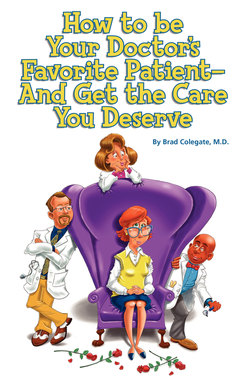Читать книгу How to be Your Doctor’s Favorite Patient - David Claytor - Страница 7
На сайте Литреса книга снята с продажи.
The Pierced Patient
ОглавлениеGillian Landers couldn’t wait to get away to college–or perhaps more accurately, away from the parents who controlled every aspect of her life. Two hundred miles and three hours away from her small town, she was free now–free to party, to play–and get pierced. She’d been wanting to get her belly-button pierced ever since she saw a model in Elle with a gold-and-emerald ring in her mid-section. Her mother had let her get her earlobes pierced, of course, but that was nothing special, and both her parents had thrown a fit when she said she wanted her belly-button done.
It didn’t hurt much when the guy at “The Nifty Needle” did it–he was a pro who did his work as easily and as casually as a seamstress darning a sock. But two days later it began to be painful, and pus was oozing from the puncture site. By the time she sheepishly made her way to the doctor’s office in another two days, there was also redness and swelling for an inch all the way around the ring.
“I’ll put you on an antibiotic, but that ring’s going to have to come out, at least until this is all healed,” advised Dr. Lois Gavin. “Otherwise, it acts as a hiding place for the bacteria.”
Gillian burst into tears. “I should have listened to my mother. She told me it would get infected.” Composing herself, she continued, “I don’t want this to happen again. Would you do the piercing for me next time, doctor?”
“No,” she said, “I don’t do piercing.”
“Why not?”
“Because it’s really a cosmetic, not a medical, procedure.”
“I think maybe you don’t want to because you’re like my parents and you think it’s weird.”
“Well, I do happen to think the human body looks better without any extra holes in it.”
Body-piercing is a practice that has become very popular, especially among teenagers and college students. For some, it’s a wild new fashion, a bold declaration of nonconformity. Arguments against it range from the aesthetic: “it’s ugly”; to the practical: “how does he blow his nose with that thing in?”; to the moralistic: “it’s mutilating your God-given body.” From a medical standpoint, there are no advantages to piercing (one doesn’t absorb iron into the blood from a steel ring, for instance), but there are certain risks, and therefore many physicians are against the practice. The pain caused by the procedure is highly subjective; many claim after a piercing that “it didn’t hurt at all.”
Bleeding can be a problem if the site isn’t chosen properly, and keloid formation (excessive scarring) can occur in some individuals. Infection is the main risk–not so much from the piercer (although certainly it’s important for the piercer to use proper hygiene and technique)—but rather from your own skin bacteria invading the wounded flesh. So, if you have a piercing done, keep the site scrupulously clean until (and even after) it has healed. But if complications develop, don’t be afraid to see your doctor; she’ll help you get better—even if she does give you a “piercing look” of admonishment.
Do carefully select a qualified piercer before you get any piercing done.
Don’t get pierced in a drunken or drug-induced state, or you may agree to something you’ll regret when you’re sober.
Do see your doctor right away if signs of infection appear.
Do expect not to get a lecture on the “evils” of piercing.
